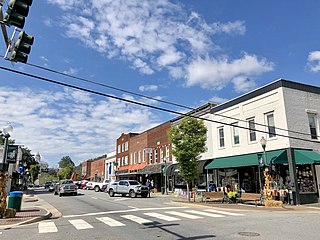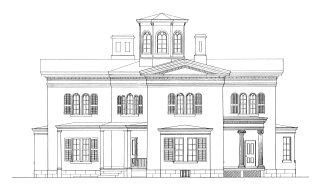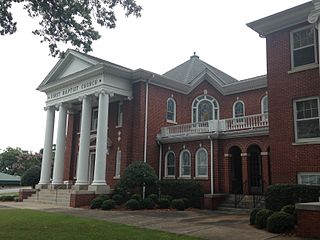
Sylva is an incorporated town located in central Jackson County, in the Plott Balsam Mountains of Western North Carolina, United States. As of the 2010 census, the town had a total population of 2,588. It is the county seat, taking over the role from nearby Webster in 1913.

William Alexander Graham was a United States senator from North Carolina from 1840 to 1843, a senator later in the Confederate States Senate from 1864 to 1865, the 30th governor of North Carolina from 1845 to 1849 and U.S. secretary of the Navy from 1850 to 1852, under President Millard Fillmore. He was the Whig Party nominee for vice-president in 1852 on a ticket with General Winfield Scott.

Cooleemee, also known as the Cooleemee Plantation House, is a house located between Mocksville and Lexington, North Carolina, at the terminus of SR 1812 on the Yadkin River in Davie County, North Carolina. It is a U.S. National Historic Landmark, designated in 1978 for its architecture.

The North Carolina State Capitol is the former seat of the legislature of the U.S. state of North Carolina which housed all of the state's government until 1888. The Supreme Court and State Library moved into a separate building in 1888, and the General Assembly moved into the State Legislative Building in 1963. Today, the governor and his immediate staff occupy offices on the first floor of the Capitol.

The Nash-Hooper House, also known as the William Hooper House, is a historic house at 118 West Tryon Street in Hillsborough, North Carolina. Built in 1772 by American Revolutionary War general Francis Nash, it was home from 1782–1790 to Founding Father William Hooper, a signer of the United States Declaration of Independence. It is the only known home of Hooper's to survive, and was declared a National Historic Landmark in 1971. It is located in the Hillsborough Historic District; it is a private residence, and is not normally open to the public.

The Carson House is a historic house and museum located in Marion, North Carolina. It was the home of Col. John Hazzard Carson, and served as the McDowell County courthouse when the county was first organized in 1842.
Hooper House may refer to:

Forest City Baptist Church, also known as First Baptist Church, is a historic Baptist church building located at 301 W. Main Street in Forest City, Rutherford County, North Carolina. It was designed by architect James M. McMichael and built in 1915. It is a two-story, cruciform plan, Classical Revival-style brick building. It consists of an octagonal core surmounted by an eight-sided, slate-covered, pyramidal roof from which rectangular pedimented-gable wings project on the four sides. Adjoining the church is the Alexander Memorial building, built in 1927.

The Fairfield Inn was an historic hotel building located on Fairfield Lake near US Highway 64 in Cashiers, Jackson County, North Carolina. It was built in 1896-1898, and consisted of a 2 1/2-story main block with two rear wings. The Queen Anne style frame building featured three massive singled gables, hipped dormers, a three-story corner turret, elliptical windows, and a one-story lakeside verandah. The hotel had 100 rooms.

Chamber of Commerce Building, also known as the North Greenville College Building, is a historic office building located at Greenville, South Carolina. It was built in 1925, and is a ten-story rectangular brick sheathed steel frame building. The Chicago School style skyscraper consists of a two-story base with Neoclassical detailing, a seven-story shaft, and a roof story that features tall arched windows and a brick and stone frieze with transoms and stone panels.

Stagg House, also known as the Dr. Bradley House, is a historic home located at Burlington, Alamance County, North Carolina. It was built between 1857 and 1859, and is a two-story, T-shaped, frame dwelling. Connected to the main block are numerous one-story wings that appear to date to the late-19th century. It has a large wraparound porch and features a rectangular projecting front bay with tall and narrow windows. It is one of only a few antebellum houses surviving in Burlington.

Dr. David P. Weir House is a historic home located at Greensboro, Guilford County, North Carolina. It was built about 1846, and is a two-story, frame structure with Greek Revival and Italianate style design elements. It has a low hip roof pierced by two interior chimneys and a one-story kitchen wing. The house was expanded in 1961 by created a large meeting space at the front of the house for the Greensboro Woman's Club. The house may have been built from a plan provided by the well-known New York architect Alexander Jackson Davis.

Gen. William C. Lee House is a historic home located at Dunn, Harnett County, North Carolina. It was built about 1915, and is a two-story, three-bay, double pile, Classical Revival-style brick veneer mansion with a hipped roof. It has one-story rear wings and features a full facade porch with monumental Tuscan order columns. It was the home of World War II General William C. Lee, whose wife acquired it in 1935. The house contains offices for the Dunn Area Chamber of Commerce and a museum memorial to the General.

Roberts-Vaughan House is a historic home located in the Murfreesboro Historic District at Murfreesboro, Hertford County, North Carolina. It was built about 1805, as a two-story, five-bay, Federal style frame dwelling with a gable roof. The front facade features a large three bay tetrastyle pedimented portico in the Greek Revival style. It was built by Benjamin Roberts, a prominent local merchant.

Clayton Banking Company Building is a historic bank building located at Clayton, Johnston County, North Carolina. It was built in 1919–1920, and is a two-story rectangular brick block faced with Indiana limestone in the Beaux-Arts style. The front facade includes a pair of three-quarter Ionic order columns "in antis" framing the double front doors. The building houses the Clayton Chamber of Commerce.
Dr. Hassell Brantley House is a historic home located at Spring Hope, Nash County, North Carolina. It was built in 1912, and consists of a two-story, five-bay, central block with two-story gable roofed wings. A has a one-story rear kitchen wing with a hip roof. The front facade features full-height, Classical Revival pedimented portico, with Ionic order columns and a wrap-around porch.

Dr. Evan Alexander Erwin House is a historic home located at Laurinburg, Scotland County, North Carolina. It was built in 1904, and extensively remodeled in 1939 in the Classical Revival style. It is a two-story, five-bay, double pile, frame dwelling, with one-story side-gable flanking side wings. It features a two-story front porch with a flat roof and supported by four square slender wood columns with Tuscan order caps. Also on the property is a contributing two car garage.
Little Manor, also known as Mosby Hall, is a historic plantation house located in Warren County, North Carolina near the town of Littleton. It was built about 1804, and is a Federal style frame dwelling consisting of a two-story, five-bay, pedimented main block flanked by one-story wings. It has a pedimented center bay front porch with Doric order pilasters and an older two-story rear wing, dated to about 1780.
Dr. Charles and Susan Skinner House and Outbuildings, also known as Linden Hall, is a historic plantation house located in Warren County, North Carolina near the town of Littleton. It was built between 1840 and 1844, and is a two-story, three-bay, single-pile, T-shaped Greek Revival style frame dwelling with a hipped roof. It has two hemioctagonal wings and three porches. Also on the property are the contributing kitchen (1840-1844), dairy (1840-1844), smokehouse (1840-1844), necessary (1840-1844), and two dependencies (1840-1844).
Dr. H. D. Lucas House was a historic home located at Black Creek, Wilson County, North Carolina. It consisted of two sections: a one-story Greek Revival style doctor's office built about 1850, and a late-19th century, Victorian cottage dated to the early 1880s, which served as Dr. Lucas' residence. The cottage was a one-story, three-bay, single-pile frame dwelling with a steeply pitched gable roof. The house has been demolished.



















